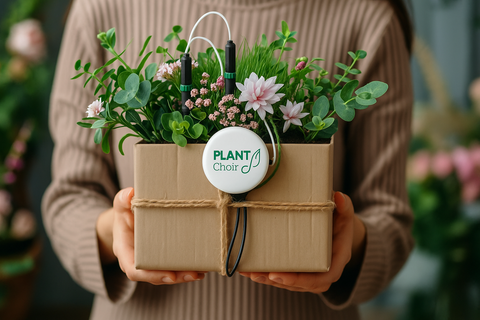If you have ever walked into a room full of glossy leaves and instantly felt your shoulders drop, you already know the vibe. Houseplants reduce stress and make spaces feel grounded and alive. People also ask about air quality. Do houseplants actually improve the air we breathe. The honest answer is that plants can support a fresher feeling environment and a calmer mood. Their direct air cleaning in a typical home is modest, but their impact on stress is real and widely reported. Add music that helps your body settle, especially music that responds to your plants in real time, and you get a daily ritual that feels modern, mindful, and easy to stick with.
![]()
What plants are doing for your head and your body
Being around plants is more than decor. Studies show real shifts in the body when people interact with indoor greenery. Hands in soil, repotting, trimming a leaf, even simple watering can calm the nervous system. People often report feeling soothed, more comfortable, and more present after short plant sessions. It feels a lot like the first deep breath after a long day.
Why it works comes down to a few basics. Plants pull your attention into the moment using sight, touch, and sometimes scent. That soft sensory focus lowers mental noise and gives your brain an easy anchor. Many folks describe better attention and a refreshed headspace after tending a fern for five minutes. That tiny pause becomes a mini reset that is simple to repeat.
On the physical side, indoor greenery is linked with comfort and mood support. Some hospital settings that add plants or green views see patients report less pain and an easier recovery experience. At home, people often notice less fatigue and fewer headaches when they keep up simple plant care. Keep expectations grounded. Plants are not a treatment or cure. They are a supportive, everyday tool that helps you feel more at ease.
![]()
The air question people keep asking
You have probably seen lists that say ten plants that purify your home. The origin story is a NASA experiment that tested plants in sealed chambers. Helpful for space habitats, not a one to one match for your living room. Later reviews explain that to copy those chamber results in a regular home, you would need a lot of plants per square meter. Not exactly realistic for a studio apartment.
So what actually helps your indoor air. Think habits. Ventilation, source control, and filtration do most of the heavy lifting. Plants play a supportive role by adding a touch of humidity and catching dust on leaves you wipe away. The best plan is a both approach. Use the practical air moves that work, and let plants elevate the feel of the room so you are more likely to keep those habits going.
![]()
Easy air habits that pair perfectly with plants
-
Open a window for a few minutes when outdoor air is decent
-
Run your range hood while cooking and your bath fan during showers
-
Choose low VOC paints, finishes, candles, and cleaners
-
Vacuum and dust weekly so particles do not pile up on shelves and leaves
-
Use a HEPA purifier sized for the room
-
Keep humidity around forty to fifty percent for comfort and plant health
Plants set the mood. These habits move the needle.
![]()
Caring for plants feels like caring for you
Plant care is self care in disguise. Checking soil moisture is a quick mindfulness cue. Wiping a leaf with a damp cloth slows your pace and gets you out of your head. Turning a pot toward the light is a tiny moment of attention that resets your day. The best part is that it takes two minutes. You do not need a spa day to feel better. You just need a habit you enjoy repeating.
![]()
Starter plants that keep the vibe calm and the routine easy

-
Snake plant, also called Sansevieria, is chill with low light and light watering
-
ZZ plant has shiny leaves and a clean silhouette that looks good anywhere
-
Pothos and classic heart leaf Philodendron trail, climb, and grow fast
-
Peace lily brings sculptural leaves and occasional white blooms
-
Spider plant is cheerful and kid friendly with little plantlets you can share
-
Rubber plant adds drama and loves bright indirect light
Lavender and jasmine are also favorites for soothing scent if you have the light. Rosemary brings that woodsy note people love during focus time. For air supportive picks, snake plant and aloe show up on many go to lists because they are simple to own. Remember, scent and presence influence mood. Your routine is the magic.
![]()
Music is your second nervous system helper
Music tells your body it is safe to relax. Reviews and meta analyses show that calming music can reduce stress, lower heart rate, and ease tension. It also taps the brain’s reward system, which is why the right track feels like a pressure valve. Slow, simple, and gentle tones are great for unwinding. More rhythmic but still soft textures work well for creative work and study. You are not trying to hype yourself up. You are aiming for steady and centered.
If you have ever put on an ambient track and felt your shoulders melt, you know the effect. Some lab studies even report big drops in anxiety during carefully chosen calming pieces. Your results will be personal, but the direction is clear. Music helps the body and mind exhale.
![]()
![]()
Put plants and plant made music together for a ritual that sticks
Since you already know PlantChoir, here is the simplest way to combine everything you love. Clip the sensor to a healthy leaf, open the app, and let your plant’s bio signals shape gentle sound while you sit nearby. The plant gives your eyes a calm focal point. The music gives your breath a rhythm to follow. Together, they make it easier to stay present and feel good.
![]()
Try this ten minute flow
-
Set the scene
Pick one plant you love. Wipe dust from a leaf, take a sip of water, and open a window for a quick refresh if the air feels stale. Sit where your back feels supported. -
Press play
Start your plant made music and choose instruments that feel soft. Pads, harp, mellow piano, or light chimes are all solid choices. Keep the volume low and cozy. -
Breathe and notice
Inhale for four counts and exhale for six. If your mind wanders, gently look at one leaf and follow the sound for a few bars. That is it. No extra rules. -
Wrap with care
Unclip gently. Rotate the pot a quarter turn. If the soil is dry, water thoroughly and let it drain. Jot one sentence about how the sound felt today. Routine locked.
![]()
Quick routines you can slot into busy days
-
Two minute green break before a meeting
-
Morning creative priming while journaling or sketching
-
After work reset with lights low and soft plant tones
-
Family curiosity time to let kids hear how the melody shifts
Low friction equals more follow through. Make it tiny and repeatable.
![]()
Everyday maintenance that keeps both the plants and the music happy
Healthy leaves mean steadier signals and a better listening experience.
-
Match light to the plant and rotate for even growth
-
Water by feel and let pots drain fully to avoid soggy roots
-
Use room temperature water and consider letting tap water rest if chlorine is high
-
Feed lightly in spring and summer according to label directions
-
Trim yellowing leaves and wipe dust every few weeks
-
Repot when roots circle the pot, ideally in spring
-
Keep an eye out for pests and act early with gentle methods
These basics keep your plants thriving, your space looking fresh, and your sound sessions smooth.
![]()
Friendly expectations and honest boundaries
Plants are not clinical tools and music is not a cure. What they offer is daily support that helps many people feel calmer, more focused, and more at home in their space. The NASA chamber study was designed for sealed environments. Modern reviews emphasize ventilation and filtration for measurable air improvements, while letting plants play a small, supportive role. The strongest benefits from plants show up in how we feel and function. Pair that natural presence with gentle audio shaped by your plant and you have a habit that is personal, creative, and sustainable.
Setup Tutorial: Clips, Soil Probes, and Wet Gels
Use Cases at Home, Yoga, and Events
Pick one plant you already love. Clip, connect, and give yourself ten minutes of listening while you breathe slowly.
Save your favorite sound combo in the app so it is one tap next time.
Repeat tomorrow and let your living room become your calm studio.
![]()








